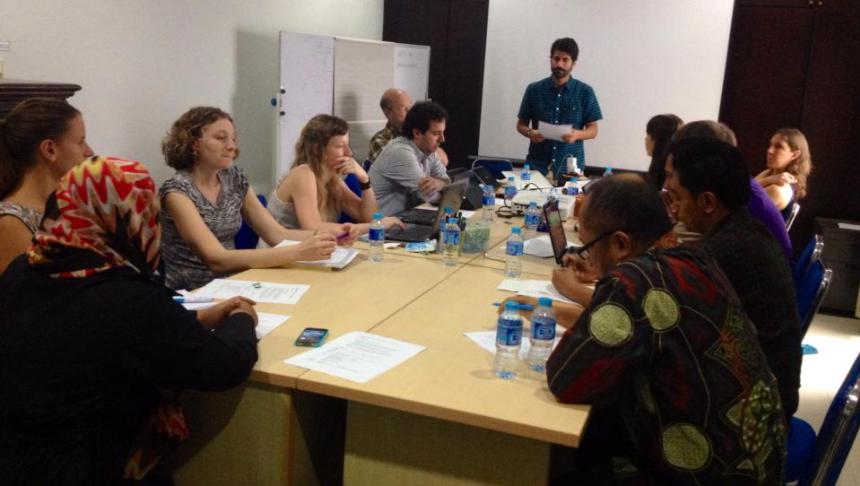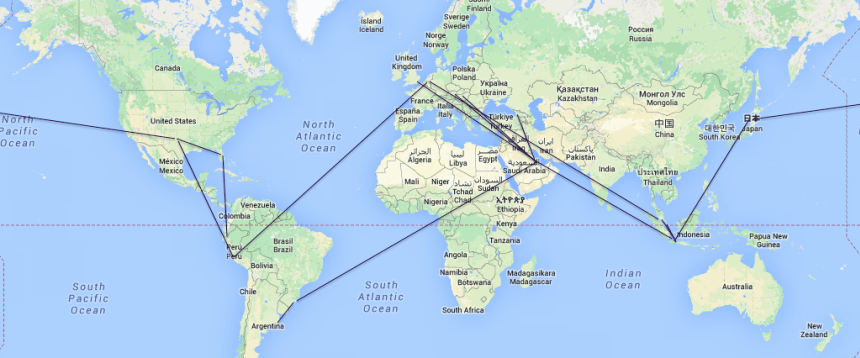Once again, thinktankers from 10 different organisations and 9 countries came together, this time, in Jakarta, Indonesia. The objectives of this second meeting of The Exchange are:
- Kick-start the collaborative projects: each team will make progress in presenting initial research/work, make specific plans, and/or develop tools, questionnaires, or other things that require close collaboration.
- Learn about Indonesian think tanks (and their context): the participants will have an opportunity to learn more about Indonesian think tanks and the challenges and opportunities they face.
- Reflect on ‘lessons so far’ about collaboration: the participants will share their own reflections regarding barriers and opportunities for collaboration based on their experiences so far.
The first day was an opportunity to reacquaint ourselves with each other as well as to introduce new participants.
The outline for the first day of the workshop was as follows:
| 10am | Leave to Article 33 |
| 1030am-1130am | Introduction: welcome, objective of the Workshop, agenda. |
| 1130am – 1230am | Re-introductions to the think tanks. Each participant briefly introduces his or her think tank to each other focusing on a paradigmatic aspect of their organisation:“To understand our think tank you must understand this ….” |
| 1230am – 130pm | LUNCH |
| 130pm-4pm | Introduction to Indonesian think tanksPresentations and Q and A |
| 4pm-5pm | Team work to start work on the collaborative projects:
|
| Free evening |
After some welcome remarks from Article 33’s director, Chitra Hariyadi, and Ben Hillman from the Knowledge Sector Initiative, we provided a quick update of progress since the last meeting in Lima:
This included a reference to the setting up of the teams (on Performance and Communications), some changes in among the participants (both Article 33 and IRE, in Indonesia, nominated new participants to The Exchange), developing the proposals, the reviews by a panel of experts and, finally, the organisation of this event.

Participants during the introduction to the workshop: From bottom left clockwise: Ermy, Dora, Irina, Renata, Leandro, Stephen, Enrique, Radka, Francesca, Balàzs, Hari, Krisdyatmiko, and Bambang,
To help remind ourselves of the think tanks in The Exchange and to ensure that we continue to learn about each other, the participants then proceded to some interesting information about their organisations.
The were asked to complete the sentence: To understand our think tank you must first understand…
- IEP: You must first understand that IEP was founded 50 years ago by a group of intellectuals including writers, historias, poets and anthropologists, from different regions of Peru, who wanted to create an institutions that was pluralistic and independent.
- CENAA: You must first understand CENAA’s logo: it is based on the logo of NATO. CENAA was set up to study European security policy and European security policy cannot be separated from NATO. CENAA is a small think tank in a small country in Europe. It works and co-operates with associates, preferring this approach to growing in numbers.
- Budapest Institute: You must be a fly on the wall at the annual meeting of the four founding members. It involves a ‘ritual’ in which each member draws a triangle symbolising the three pillars of the organisation: impact, quality, and integrity. They score each pillar and then compare their scores leading to a lively debate between the partners. You must also understand that the Budapest Institute is set up as a limited company yet it fulfils the same ‘charitable’ functions of a think tank.
- IRE: You must understand that it was set up during the New Order regime of Suharto. Its researchers are mostly lecturers at university from different disciplines.
- Article 33 Indonesia: You must understand the Indonesian Constitution and its 33rd article which speaks of ensuring that Indonesian natural resources benefit the Indonesian people. Article 33 aims to defend and promote this article. It was founded as the research wing of PATTIRO, an advocacy organisation in Indonesia: PATTIRO Institute. It was then renamed Article 33 Indonesia and ‘split’ from PATTIRO.
- EPRC: You must understand that it was founded by a group of young western educated policy entrepreneurs in 2002. EPRC, unlike most think tanks also performs watch-dog and capacity building functions.
- CEBRI: You must understand that CEBRI was founded by a group of senior former diplomats in 1998 who wanted Brazil to have an equivalent to the Council of Foreign Relations. Changes in the government since then have meant that the centre, and mostly its board members, became associated with the ‘old’ regime and had to work hard to develop new connections. These new connections are aided by a younger staff.
- Grupo Faro: You must understand the context in which it was founded. Ecuador had emerged from a period of great instability in which 7 presidents had been replaced in 6 years. In this context of weak institutions Grupo Faro sought to strengthen the State. Since 2007, the situation has changed and the State has emerged as a stronger player; thus Grupo Faro has turned its attention to strengthening other actors int he public space.
- CIPPEC: You must understand that CIPPEC was founded in 2000 by a group of young Harvard graduates supported by individuals on the “right” of the political spectrum. This has meant that CIPPEC has had to pay particular attention to the perception people have of it and has developed a number of strategies to address this perception. CIPPEC is also unique in that it places a great deal of attention to internal organisational matters, including its communications capacity.
Following lunch, Article 33 and IRE presented their organisations in greater detail:
The day finished with the participant’s going over their plans for the week. We asked them to outline their objectives for the workshop to ensure that they would be able to focus their attention:
The Communications team:
- Initial mapping to see “how it works”
- To go through the terminology and basic concepts
- discuss the notions and types of “communication”
- discuss the notion of “building democracy”
- To discuss criteria to select the case studies
- To take a team picture on a boat
- What to do about the last phase (rephrase the component 4)
- To clean our dropbox folder and organize it better
The Performance team:
- Define the performance area(s) to be assessed
- Define how it will be assessed
- Define the case studies’ structure (methodological frame)
- Define a detailed timeline
- Finetune the final proposal accordingly
As a reminder of the efforts made by the participants we asked them to answer the question: so how long did it take you to get here? We turned it into a map:



 Previous
Previous
